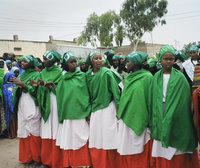There was a time in the 1960s and 1970s when Somali clans across East Africa imagined a "pan-Somalia" encompassing former British, Italian and French colonies, in addition to portions of eastern Ethiopia and northern Kenya. The former British and Italian colonies -- Somaliland in the north, and the southern U.N. Trust Territory of Somalia, respectively -- had taken a tentative first step towards realizing this greater Somali state, when they merged in 1960 to form the Republic of Somalia.
But the greater union was not to be. The former French colony declared independence, as Djibouti, and Ethiopia and Kenya each held onto their Somali regions. The Republic of Somalia began to fracture in the late 1980s, following decades of clan favoritism and repression under dictator Siad Barre. In 1991, the Somali National Movement (SNM), founded in 1981 to resist Barre's regime, ejected the last of Barre's troops from northern Somalia, and Somaliland declared its independence.
Nearly two decades later, Somaliland, population 3.5 million, is a rare bright spot on the Horn of Africa's political landscape. The country is at peace and growing economically, in stark contrast to the south, where Islamic extremists and clan factions continue to wage brutal civil warfare. Despite its successes, Somaliland has never been officially recognized by other nations or by world bodies such as the African Union and U.N. "Many Western countries are blindly parroting the A.U. dictum that Africa's post-colonial borders are sacrosanct," explained Ahmed Egal, a founding member of the SNM.

